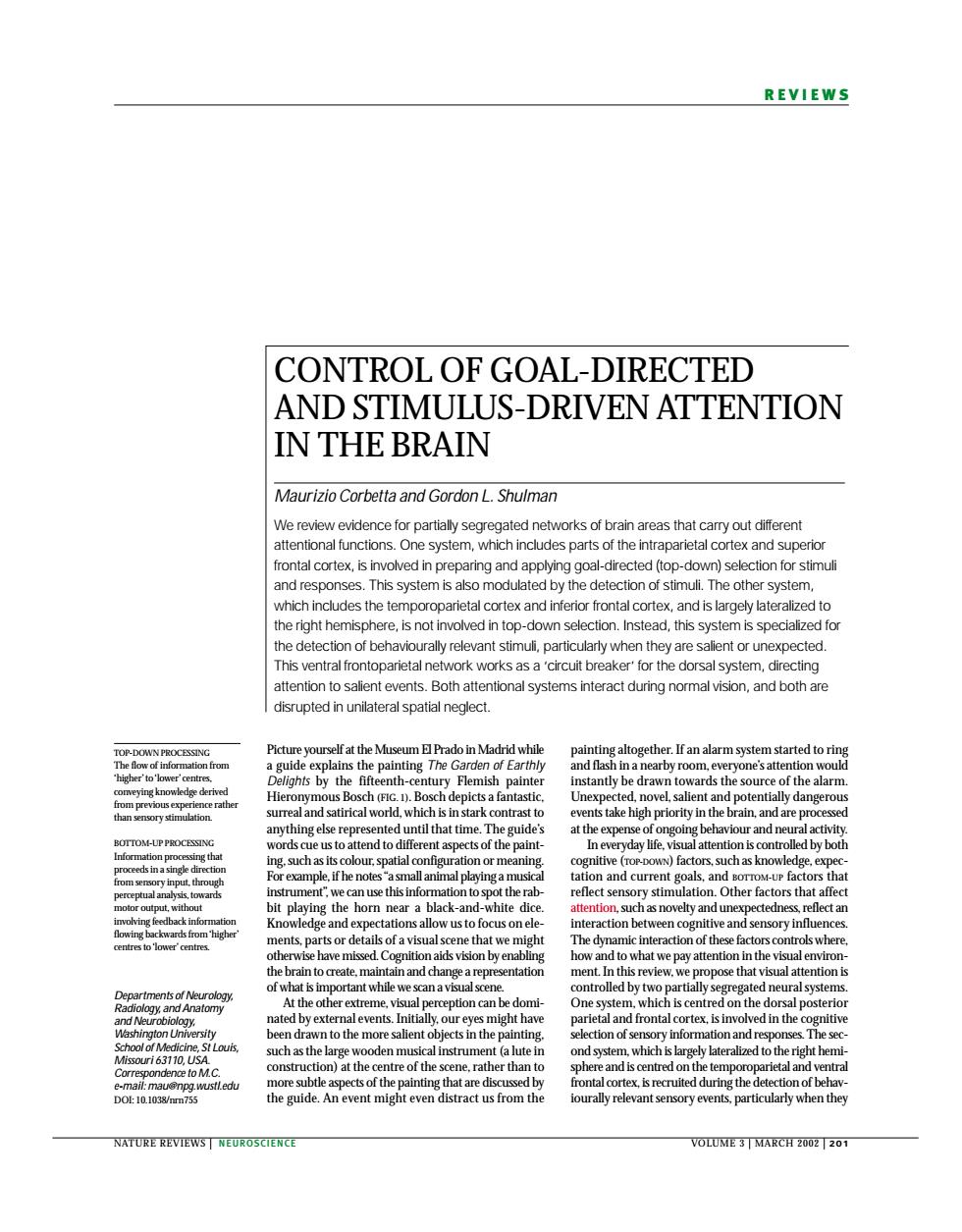正在加载图片...

REVIEWS CONTROL OF GOAL-DIRECTED AND STIMULUS-DRIVEN ATTENTION IN THE BRAIN Maurizio Corbetta and Gordon L.Shulman ngnono ocon co sm works of brain areas that cary out diferent ctions.One system. udes the ter etal cortex and inferior frontal co the right hemisphere.isnot invlved in top-down selection.Instead,this system is specialized for the detection of behaviourally relevant stimull,particularly when they are salent or unexpected. This ventral frontoparletal network works as a'circult breaker for the dorsal system,directing attention to saient events.Both attentional systems interact during normal vision,and both are disrupted in unilateral spatial neglect. pantigatogetheranlhmystestertediotg by the e wards the sou fa ors tha 吃ge black-a -white dice andse that we migh The dynami ls wher we tion can be de on the been drawn to the n Th Dt175 NATURE REVTEWST SCIENC OLUME 3TMARCH 26022REVIEWS NATURE REVIEWS | NEUROSCIENCE VOLUME 3 | MARCH 2002 | 201 Picture yourself at the Museum El Prado in Madrid while a guide explains the painting The Garden of Earthly Delights by the fifteenth-century Flemish painter Hieronymous Bosch (FIG. 1). Bosch depicts a fantastic, surreal and satirical world, which is in stark contrast to anything else represented until that time. The guide’s words cue us to attend to different aspects of the painting, such as its colour, spatial configuration or meaning. For example, if he notes “a small animal playing a musical instrument”, we can use this information to spot the rabbit playing the horn near a black-and-white dice. Knowledge and expectations allow us to focus on elements, parts or details of a visual scene that we might otherwise have missed. Cognition aids vision by enabling the brain to create, maintain and change a representation of what is important while we scan a visual scene. At the other extreme, visual perception can be dominated by external events. Initially, our eyes might have been drawn to the more salient objects in the painting, such as the large wooden musical instrument (a lute in construction) at the centre of the scene, rather than to more subtle aspects of the painting that are discussed by the guide. An event might even distract us from the painting altogether. If an alarm system started to ring and flash in a nearby room, everyone’s attention would instantly be drawn towards the source of the alarm. Unexpected, novel, salient and potentially dangerous events take high priority in the brain, and are processed at the expense of ongoing behaviour and neural activity. In everyday life, visual attention is controlled by both cognitive (TOP-DOWN) factors, such as knowledge, expectation and current goals, and BOTTOM-UP factors that reflect sensory stimulation. Other factors that affect attention, such as novelty and unexpectedness, reflect an interaction between cognitive and sensory influences. The dynamic interaction of these factors controls where, how and to what we pay attention in the visual environment. In this review, we propose that visual attention is controlled by two partially segregated neural systems. One system, which is centred on the dorsal posterior parietal and frontal cortex, is involved in the cognitive selection of sensory information and responses. The second system, which is largely lateralized to the right hemisphere and is centred on the temporoparietal and ventral frontal cortex, is recruited during the detection of behaviourally relevant sensory events, particularly when they CONTROL OF GOAL-DIRECTED AND STIMULUS-DRIVEN ATTENTION IN THE BRAIN Maurizio Corbetta and Gordon L. Shulman We review evidence for partially segregated networks of brain areas that carry out different attentional functions. One system, which includes parts of the intraparietal cortex and superior frontal cortex, is involved in preparing and applying goal-directed (top-down) selection for stimuli and responses. This system is also modulated by the detection of stimuli. The other system, which includes the temporoparietal cortex and inferior frontal cortex, and is largely lateralized to the right hemisphere, is not involved in top-down selection. Instead, this system is specialized for the detection of behaviourally relevant stimuli, particularly when they are salient or unexpected. This ventral frontoparietal network works as a ‘circuit breaker’ for the dorsal system, directing attention to salient events. Both attentional systems interact during normal vision, and both are disrupted in unilateral spatial neglect. TOP-DOWN PROCESSING The flow of information from ‘higher’ to ‘lower’ centres, conveying knowledge derived from previous experience rather than sensory stimulation. BOTTOM-UP PROCESSING Information processing that proceeds in a single direction from sensory input, through perceptual analysis, towards motor output, without involving feedback information flowing backwards from ‘higher’ centres to ‘lower’ centres. Departments of Neurology, Radiology, and Anatomy and Neurobiology, Washington University School of Medicine, St Louis, Missouri 63110, USA. Correspondence to M.C. e-mail: mau@npg.wustl.edu DOI: 10.1038/nrn755